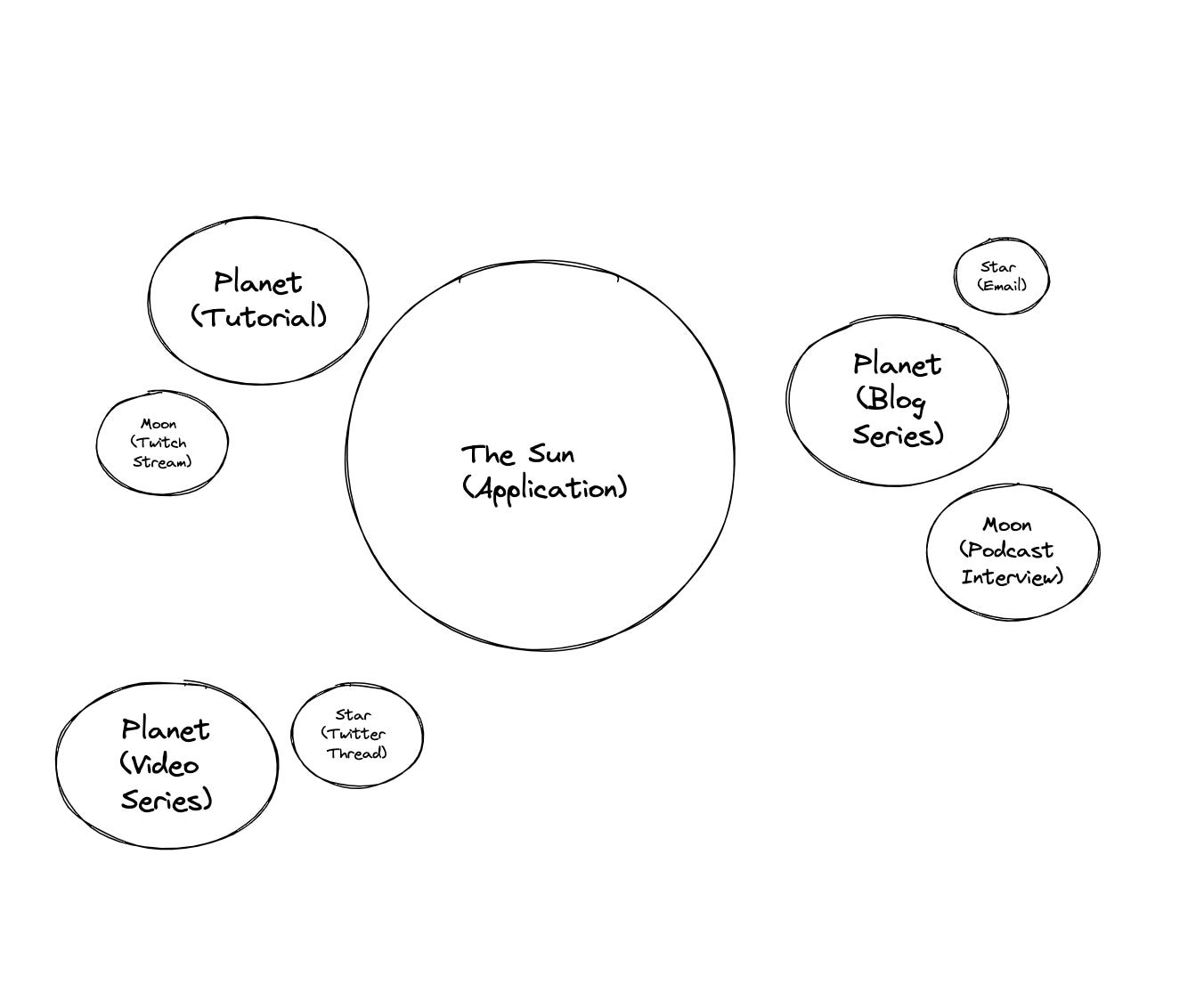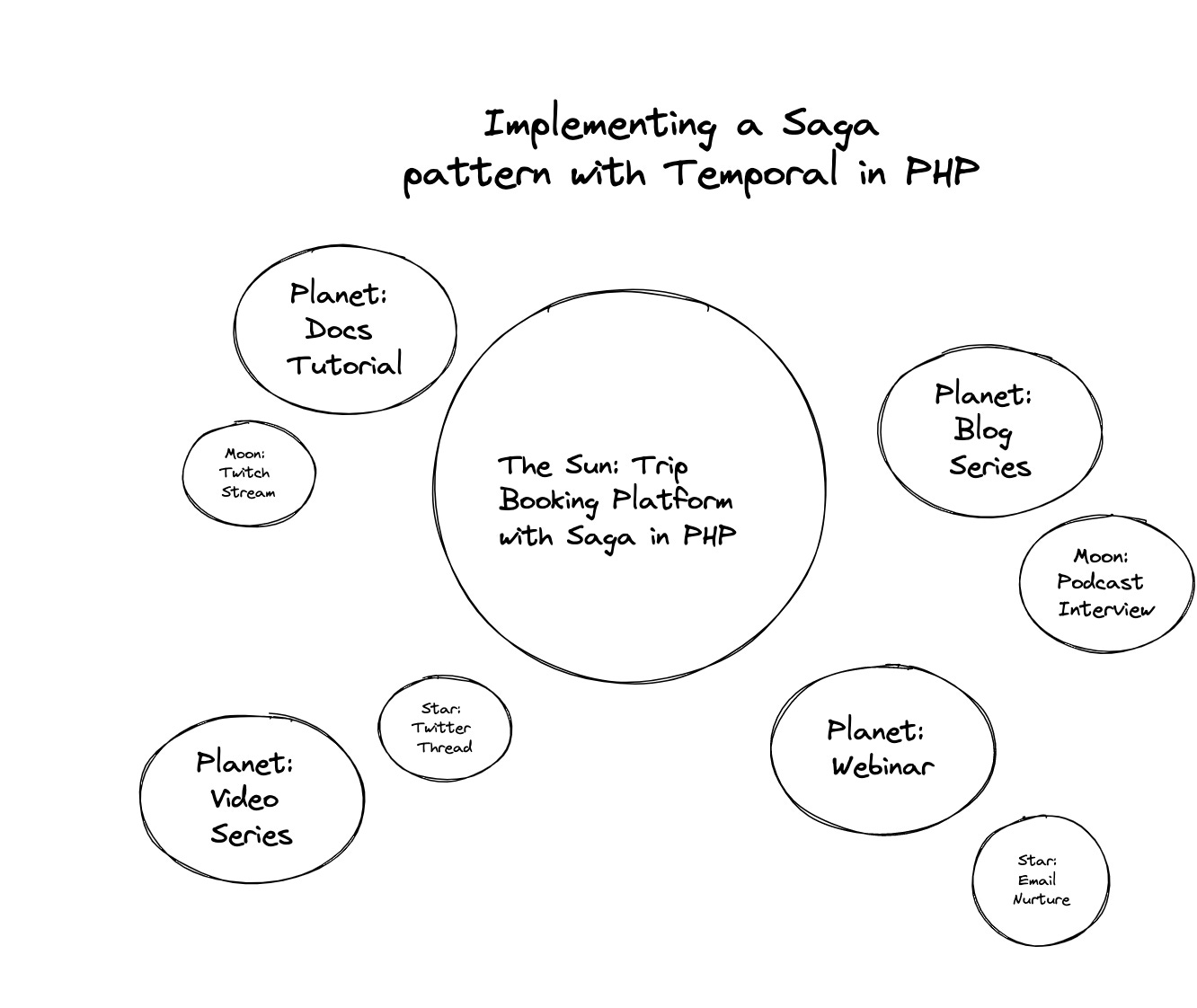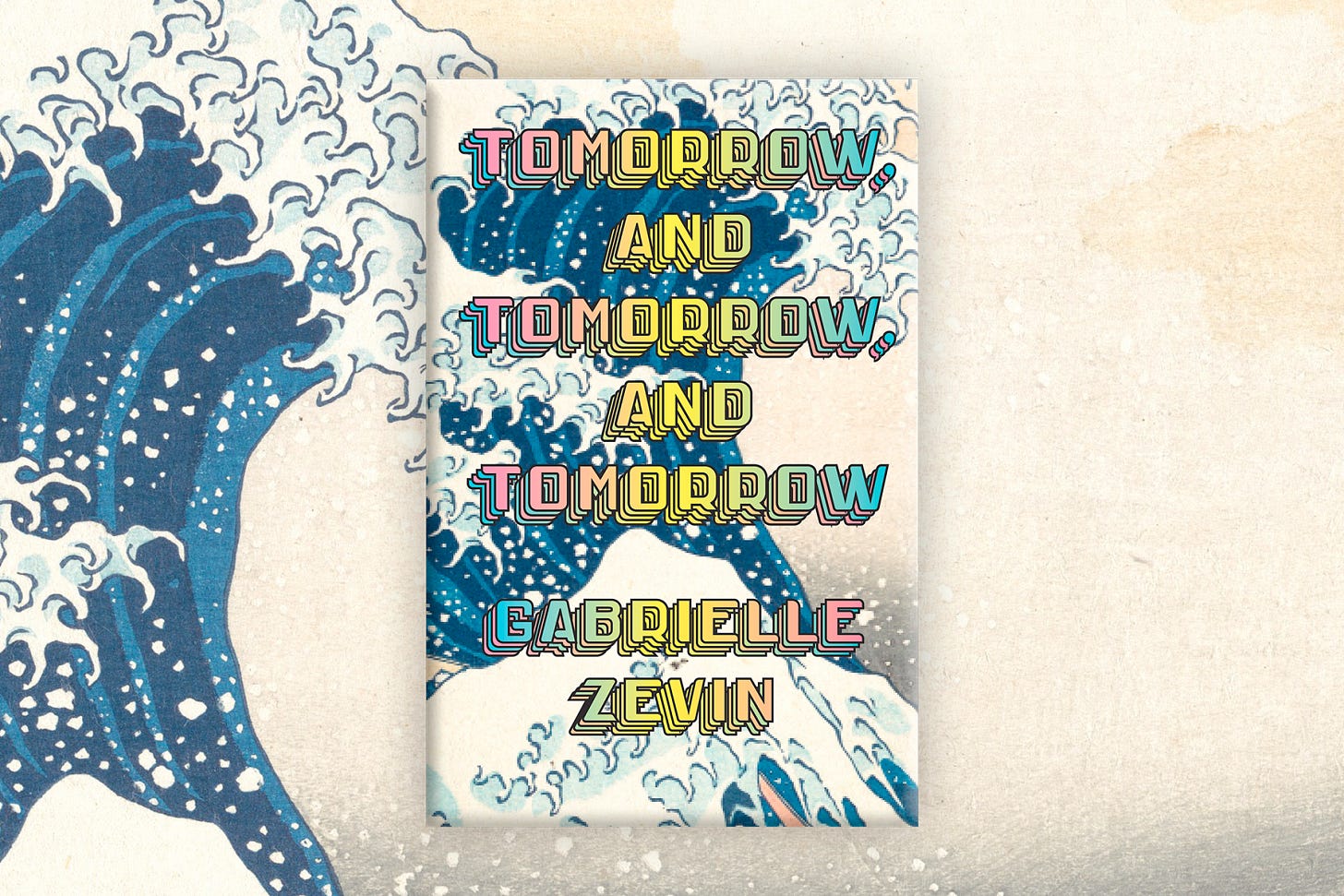Hello! I know many of you are new here — thank you so much for following DevFirst! My articles are based on conversations I have with founders and operators building Developer Tools and bringing them to market. This week’s post is about CONTENT, the King of them all!
Specifically, I’d like to talk about a delightful model for content development and recycling that I call “The Content Galaxy.” I know that many organizations struggle to determine how much content to create, identify content creators, and articulate challenges to their users. The Content Galaxy can help you build a framework for engaging your content creators and building brand equity around core topics that are important to your audience. More specifically I have used the Content Galaxy model with DevRel teams in the past to help them prioritize their workload and focus on longer-term projects that drive performance (e.g. impressions and lead gen)
By using the Content Galaxy model you’ll see how to structure content opportunities for your DevRel organization. First I will introduce the Content Galaxy framework and then I’ll walk through an example. Finally, I’ll offer some guidance on how to use the framework in your own DevRel organization.
Introducing the Content Galaxy framework
No Developer wants to admit it, but when you are doing DevRel you’re doing advanced content marketing. Of course, there’s more to DevRel – engaging with your community, supporting local developers, being a connector within your community – but when we think about the performance metrics associated with DevRel, many of them are achieved through quality content marketing. Content marketing of this kind can be defined by a few characteristics
Creating quality content based on what your community’s needs
Aligning that content to your product’s core value
Distributing that content through relevant channels to drive impressions
Building that content into growth loops to drive evergreen impressions
Measuring the impact of the content you create
Many teams struggle to create a lot of high-quality content. The Content Galaxy framework
allows your team to focus on building a large asset at the beginning which then leads to creating smaller, more easily digestible assets to distribute across different channels.
A Content Galaxy includes
The Sun: The large content that sets the stage for all the subsequent recycled content. For DevRel organizations, this is often a sample app you create to demonstrate a problem or showcase a new solution.
Planets: These are content pieces created out of your original Sun. A tutorial based on the sample app is an example of a planet! You can and should have multiple planets as part of a Content Galaxy
Moons and Stars: These are short-form content pieces that you can simply and easily create once you have a Sun in place! For example, Twitter threads, TikToks, and Emails.
Please note, I know this framework has no basis in scientific fact. This is a framework to help you with content, not to show off my knowledge of astronomy.
My favorite part about this strategy is that it’s both a content-creation tactic and a distribution strategy. From that large Sun that you create for your content Galaxy, you can then create videos for YouTube and TikToks from the same original Sun!
There are tons of ways to experiment with this as a tool for building equity around specific topics.
Case Study: Temporal
For those who aren’t familiar with Temporal, it’s the programming model of the future, based on an open-source project built at Uber called Cadence. Temporal powers microservices at Snap, ensuring seamless delivery of Taco Bell online orders and resiliency of Netflix’s real-time data and CI/CD platforms.
Temporal is ushering in a completely new mindset around resiliency, which they call Durable Execution. Developers need to understand what Temporal is and how it can evolve their infrastructure – and the fastest way to do this is by articulating different use cases where Temporal can transform your reliability and simplify operations, as I’ve done above 😀.
One of the cool use cases for Temporal is a simplification of a transaction pattern called Saga. This is a popular pattern for workflows, but often challenging to operate long-term. Temporal provides native support for this pattern, making it simpler to build and operate, so it’s a perfect use case to showcase the power and simplicity of Temporal while building the brand equity of Durable Execution as a concept.
Temporal has created a Webinar on the Saga topic and is in progress on a tutorial that goes through building a trip booking system and introduces Temporal’s native Saga pattern. Based on this, I created a content Galaxy for Temporal based on the Saga pattern in PHP.
Introduce the Content Galaxy to your team
I’ve used the Content Galaxy model with DevRel teams in the past as a way to structure a Dev Advocate’s content plan, and I’ve suggested it as a model for many more teams! It gives your team the freedom to work on something they care about, the freedom to explore something new and yet still has structure so you can manage output and, subsequently, content performance.
When assigning out the Content Galaxy approach, I’ve always emphasized
This is a time-boxed project. This gives folks guardrails around their Sun projects. They should be ambitious but not something that will take three months to build.
Start with your Sun and go from there. You will learn more as you go along. Sometimes, especially when my team was building with new software, my team members discovered application performance challenges, which then became blog posts in themselves!
Focus on something fun and exciting that will motivate you and is still important and interesting to your audience.
Not all products are positioned to recycle the Saga Galaxy – SORRY – but if you know your customers you probably know some topics that could benefit from a content Galaxy structure.
For MongoDB, my former employer, there are evergreen topics, like Schema Design, that you can truly pontificate about forever. There are SO MANY ways to design your schemas around different applications, so many perspectives around what works, and endless ways to optimize further. Schema Design as a topic is a massive Content Universe – maybe let’s call it a SuperCluster– and you can spend years building smaller Content Galaxies around that topic.
Let’s say someone on your DevRel team wanted to take Schema Design as their Galaxy for the quarter. How do you provide them with direction so that they can choose their own adventure AND have enough guidance to create a compelling enough Galaxy? I would look at the following:
What schema design challenges have I seen posted to the community this week? This month?
Are there new types of applications being built (gfab, generative AI) where a different approach to Schema Design is needed?
Are there common challenges with Schema Design you’ve seen recently?
Do you have a new perspective on this that you’d like to showcase with a new language you’re learning, like Rust?
In short, how should you pick your Content Galaxy?
Specific, not evergreen
Relevant to your community
Compelling and motivating to you
Timely, if not zeitgesty!
Articulates your brand promise and increases brand equity
I hope this framework is helpful to your team. I’d love to know if and how you use the Content Galaxy in your work.
Sides of my desk
I’m late to this, but I’m reading the most INCREDIBLE book, Tomorrow, Tomorrow and Tomorrow about two friends who love video games. It’s making me reminisce about the joys of platonic love and is making me want to play Zelda. (Goodreads)
Also this NYTimes essay on the origins and development of Zelda made me deeply nostalgic and I will probably buy Tears of the Kingdom this week, play it for one hour and give up because I’m actually terrible at video games – and its an area where I have no resolve to keep going. If you have any tips that are not 10,000 hours, please reply! (New York Times)
Deeply off topic, this Grinder (aka Hero, Hoagie) pasta salad looks like the perfect thing to bring to a piquenique. (Instagram)
My friend Carrie’s essay on our culture/country’s deep desire for fame. (The New Yorker)







Absolutely lol-ed at this "This is a framework to help you with content, not to show off my knowledge of astronomy." 🙂
Thanks for this article!